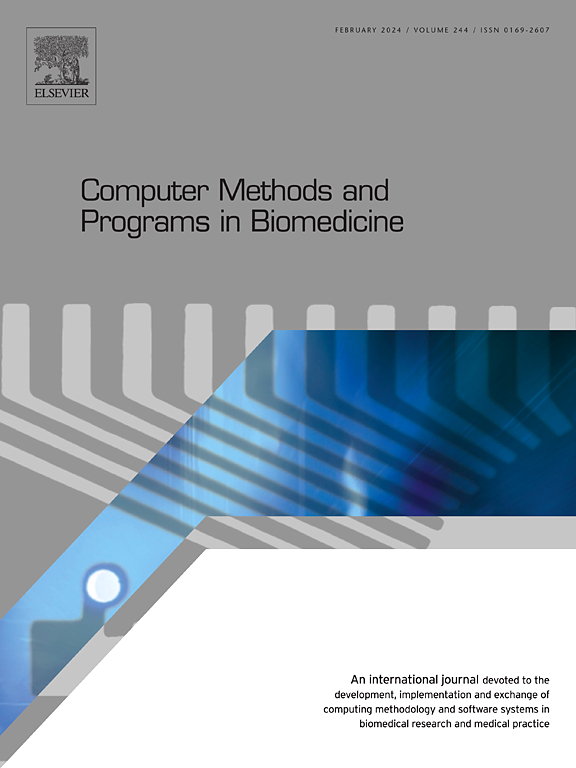Brain age prediction based on brain region volume modeling under broad network field of view
IF 4.9
2区 医学
Q1 COMPUTER SCIENCE, INTERDISCIPLINARY APPLICATIONS
引用次数: 0
Abstract
Background and objective
Brain region volume from Structural Magnetic Resonance Imaging (sMRI) can directly reflect abnormal states in brain aging. While promising for clinical brain health assessment, existing volume-based brain age prediction methods fail to explore both linear and nonlinear relationships, resulting in weak representation and suboptimal estimates.
Methods
This paper proposes a brain age prediction method, RFBLSO, based on Random Forest (RF), Broad Learning System (BLS), and Leave-One-Out Cross Validation (LOO). Firstly, RF is used to eliminate redundant brain regions with low correlation to the target value. The objective function is constructed by integrating feature nodes, enhancement nodes, and optimal regularization parameters. Subsequently, the pseudo-inverse method is employed to solve for the output coefficients, which facilitates a more accurate representation of the linear and nonlinear relationships between volume features and brain age.
Results
Across various datasets, RFBLSO demonstrates the capability to formulate brain age prediction models, achieving a Mean Absolute Error (MAE) of 4.60 years within the Healthy Group and 4.98 years within the Chinese2020 dataset. In the Clinical Group, RFBLSO achieves measurement and effective differentiation among Healthy Controls (HC), Mild Cognitive Impairment (MCI), and Alzheimer's disease (AD) (MAE for HC, MCI, and AD: 4.46 years, 8.77 years, 13.67 years; the effect size η2 of the analysis of variance for AD/MCI vs. HC is 0.23; the effect sizes of post-hoc tests are Cohen's d = 0.74 (AD vs. MCI), 1.50 (AD vs. HC), 0.77 (MCI vs. HC)). Compared to other linear or nonlinear brain age prediction methods, RFBLSO offers more accurate measurements and effectively distinguishes between Clinical Groups. This is because RFBLSO can simultaneously explore both linear and nonlinear relationships between brain region volume and brain age.
Conclusion
The proposed RFBLSO effectively represents both linear and nonlinear relationships between brain region volume and brain age, allowing for more accurate individual brain age estimation. This provides a feasible method for predicting the risk of neurodegenerative diseases.

大网络视场下基于脑区体积模型的脑年龄预测
背景与目的结构磁共振成像(sMRI)显示的脑区体积可以直接反映大脑衰老过程中的异常状态。现有的基于体积的脑年龄预测方法虽然有望用于临床脑健康评估,但未能探索线性和非线性关系,导致代表性弱和估计不理想。方法提出一种基于随机森林(Random Forest, RF)、广义学习系统(Broad Learning System, BLS)和留一交叉验证(Leave-One-Out Cross Validation, LOO)的脑年龄预测方法RFBLSO。首先,利用射频去除与目标值相关性较低的冗余脑区;目标函数由特征节点、增强节点和最优正则化参数组成。随后,采用伪逆方法求解输出系数,更准确地表示体积特征与脑龄之间的线性和非线性关系。结果在不同的数据集中,RFBLSO展示了制定脑年龄预测模型的能力,在健康组中实现了4.60岁的平均绝对误差(MAE),在中国2020数据集中实现了4.98岁的平均绝对误差。在临床组,RFBLSO实现了健康对照(HC)、轻度认知障碍(MCI)和阿尔茨海默病(AD)的测量和有效区分(HC、MCI和AD的MAE: 4.46年、8.77年、13.67年;AD/MCI与HC的方差分析的效应值η2为0.23;事后检验的效应量为科恩d = 0.74 (AD vs. MCI), 1.50 (AD vs. HC), 0.77 (MCI vs. HC))。与其他线性或非线性脑年龄预测方法相比,RFBLSO提供了更准确的测量结果,并有效地区分了临床组。这是因为RFBLSO可以同时探索脑区域体积与脑年龄之间的线性和非线性关系。结论RFBLSO有效表征了脑区体积与脑年龄之间的线性和非线性关系,可以更准确地估计个体脑年龄。这为预测神经退行性疾病的风险提供了一种可行的方法。
本文章由计算机程序翻译,如有差异,请以英文原文为准。
求助全文
约1分钟内获得全文
求助全文
来源期刊

Computer methods and programs in biomedicine
工程技术-工程:生物医学
CiteScore
12.30
自引率
6.60%
发文量
601
审稿时长
135 days
期刊介绍:
To encourage the development of formal computing methods, and their application in biomedical research and medical practice, by illustration of fundamental principles in biomedical informatics research; to stimulate basic research into application software design; to report the state of research of biomedical information processing projects; to report new computer methodologies applied in biomedical areas; the eventual distribution of demonstrable software to avoid duplication of effort; to provide a forum for discussion and improvement of existing software; to optimize contact between national organizations and regional user groups by promoting an international exchange of information on formal methods, standards and software in biomedicine.
Computer Methods and Programs in Biomedicine covers computing methodology and software systems derived from computing science for implementation in all aspects of biomedical research and medical practice. It is designed to serve: biochemists; biologists; geneticists; immunologists; neuroscientists; pharmacologists; toxicologists; clinicians; epidemiologists; psychiatrists; psychologists; cardiologists; chemists; (radio)physicists; computer scientists; programmers and systems analysts; biomedical, clinical, electrical and other engineers; teachers of medical informatics and users of educational software.
 求助内容:
求助内容: 应助结果提醒方式:
应助结果提醒方式:


